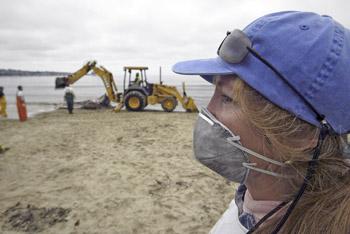
Published on Tue, Oct. 05, 2004
BLUE WHALE MAY HAVE BEEN DEAD FOR TWO WEEKS
Carcass to be buried, studied in Monterey Canyon
Herald Correspondent
Racing the clock and the tides, researchers were up to their waists in the surf Monday, sawing through the carcass of a blue whale that washed ashore on Del Monte Beach.
 |
| VERN FISHER/The Herald |
| Peggy Stap, a volunteer with the Monterey Bay Whale Watch group, watches as a tractor from Monterey Public Works disposes of pieces of the blue whale that washed up Friday on Del Monte Beach in Monterey. Members of Moss Landing Marine Laboratories were on the scene Monday to remove a variety of pieces to study in their labs. |
The cleanup is expected to be completed tonight.
It has been three days of frantic dirty work for Professor Jim Harvey of the Moss Landing Marine Laboratories and his team of graduate students, researchers and volunteers, but no one complained.
For many of the marine mammal experts, this was their first chance to see a blue whale up close.
The juvenile whale's skull and jaw bones will be trucked to the Marine Laboratories for display in the institution's scientific collection.
Pieces of blubber carved off the carcass were buried on the beach Monday to curb the smell of the decomposing flesh while allowing nutrients to return to the ocean.
Scientists from the Monterey Bay Aquarium Research Institute will collect the rest of the 40-foot carcass this afternoon. They plan to tow the whale 32 miles offshore and then sink it 9,500 feet in the Monterey Canyon.
The scientists have been monitoring another whale carcass in the canyon, and in August announced the discovery of two new species of bone-devouring worms. They will now be able to observe how quickly the worms set to work on a fresh carcass.
Forensic tests may help determine the cause of the 9-month-old whale's death, though deterioration will make the task more difficult. New estimates say the whale had been dead for a week and a half or two weeks, longer than original estimates of several days.
"It's very hard at this point to find out what the cause of death was," said Harvey.
A bloody nighttime necropsy on the beach Sunday revealed that the whale's stomach was empty.
This proves only that the whale had not eaten in the past two days, said blue whale expert John Calambokidis of the Cascadia Research collective, based in Olympia, Wash. Measurements of blubber thickness and tests of its fat content may confirm whether starvation was the cause.
The necropsy also showed that the whale had been infected by some type of parasite, evidenced by small yellow bumps on the inside of its intestines. Researchers reported a worm on the whale's tongue but are not sure whether it crawled there before or after the whale's death.
"Marine mammals typically have a lot of parasites, even when they're healthy," said Elizabeth Phillips, a graduate student who works with Harvey.
The parasites will be sent away for identification.
Harvey suggested that the whale may have been infected with domoic acid, a naturally occurring neurotoxin that has been killing sea lions, otters and dolphins on the California coast.
"No one's documented (domoic acid poisoning) in blue whales," Calambokidis said. "But that's not to say it's impossible."
Chemical tests of the whale's stomach contents may provide more information.
The whale's demise was a stroke of luck for Lauren Hoxsie, a student at CSU-Monterey Bay who is preparing to write her senior research paper on the management of dead marine mammals. She and Matthew Subia and Aubrey St. Marie, all students in CSUMB's Earth Systems Science & Policy program, have been lending a hand since Saturday.
"We were completely bloody (Sunday), but it was so worth it," Hoxsie enthused. "This is a once-in-a-lifetime opportunity."
The three students arrived at the beach after class Monday, walking barefoot or sandal-clad among the pillow-sized hunks of blubber they helped drag up the beach.
Researchers are anxious to get the whale out of the water as quickly as possible, before the blood and gore begin to attract sharks to the bay. They also want to remove the carcass for the sake of local residents who may be getting sick of the stench.
Hannah Hickey can be reached at 646-4436 or hhickey@montereyherald.com.